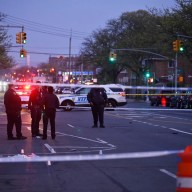By Alexander Dworkowitz
In an attempt to solve the city’s trash woes, Mayor Michael Bloomberg has unveiled a proposal to reactivate College Point’s marine transfer station along with several similar plants in other boroughs.
Bloomberg called for transporting garbage out of the city on barges instead of on trucks, the current practice.
“By upgrading our marine transfer stations, the city will have significantly greater flexibility in disposal options, vastly mitigated environmental impact and lessened vulnerability to any single disposal method or market,” Bloomberg said last week.
If enacted, the garbage plan is expected to affect the borough’s truck traffic as well as a controversial transfer facility in Willets Point.
For most of Queens, truck traffic would be reduced. In relying on marine transfer station and barges to take trash to Ohio, Pennsylvania and Virginia, Bloomberg’s plan would remove 18-wheelers, which currently handle trash from the roads.
Under the plan, the College Point facility, called North Shore and located on Flushing Bay at the end of 31st Avenue, would receive most of the borough’s garbage.
Some trash in western Queens would be directed just across the Newtown Creek to a facility in Greenpoint, Brooklyn. In the environs of the College Point and Greenpoint facilities, truck traffic would rise.
Borough leaders, however, are not worried about stepped-up truck traffic around the plants since both facilities were the destination of the borough’s garbage trucks during the years that the Fresh Kills landfill in Staten Island was in operation.
Bob LoPinto, an environmental engineer and chairman of Community Board 7’s environmental committee, said the 31st Avenue site was convenient since it is in an industrial area and just off an exit of the Whitestone Expressway.
Nevertheless, not everyone was happy when the North Shore facility was open.
“There were some complaints,” LoPinto said.
LoPinto noted some garbage trucks used to drive through residential areas in Flushing in order to get to the site. In particular, he said trucks coming from Bayside would sometimes drive down the tree-lined streets of 32nd and 35th avenues in Flushing instead of the commercial Northern Boulevard, as mandated.
The possible reopening of North Shore could also affect the region’s other waste transfer facility about a half mile away in Willets Point.
In March 2001, Tully Environmental opened a waste transfer facility at 127-20 34th Ave. in Willets Point.
Despite opposition from Flushing community leaders, Tully received a permit from the state Department of Conservation to increase the amount of solid waste it treats from 500 tons to 900 tons a day this March.
But if the city, which currently sends about 500 tons of residential trash to Tully every day, does enact Bloomberg’s plan, the Willets Point plant could lose much of its business.
“It’s very unclear what’s going to happen to these places,” said Antonia Bryson, an environmental attorney who has represented a group of Flushing residents in their fight against Tully. “It’s kind of scary.”
Tully is one of many private land-based transfer stations that have sprung up in the city in recent years. The facilities move waste from garbage trucks and onto larger trucks to be driven to dumps in Ohio, Pennsylvania and Virginia.
Trash disposal costs have shot up, increasing from $44 per ton in 1997 to more than $88 per ton in 2001, according to Sanitation Commissioner John Doherty.
In an attempt to save money, former Mayor Rudolph Giuliani had suggested taking the trash to a site in New Jersey. But staunch opposition from the other side of the Hudson River blocked the plan.
In light of Giuliani’s failure, Bloomberg suggested using eight old marine transfer stations and building a ninth in Staten Island.
Environmentalists have for the most part praised the mayor’s plan, saying hauling trash on trucks through city streets causes unnecessary pollution and contributes to asthma and lung disease.
The new plan, however, cannot be enacted swiftly.
Since the trash would be shipped hundreds of miles instead of just to Staten Island, it must be put into containers.
The eight stations do not currently have the room or the equipment needed to place the trash in the containers and must be renovated.
Lacking specifics, the city has not come up with an exact cost of renovating the eight stations and building a ninth, but Bloomberg estimated the price tag at a few hundred million dollars.
If the City Council approves a more detailed version of the plan, Bloomberg hopes the new system will take effect in about two years.
Reach reporter Alexander Dworkowitz by e-mail at Timesledger@aol.com or call 229-0300, Ext. 141.

































